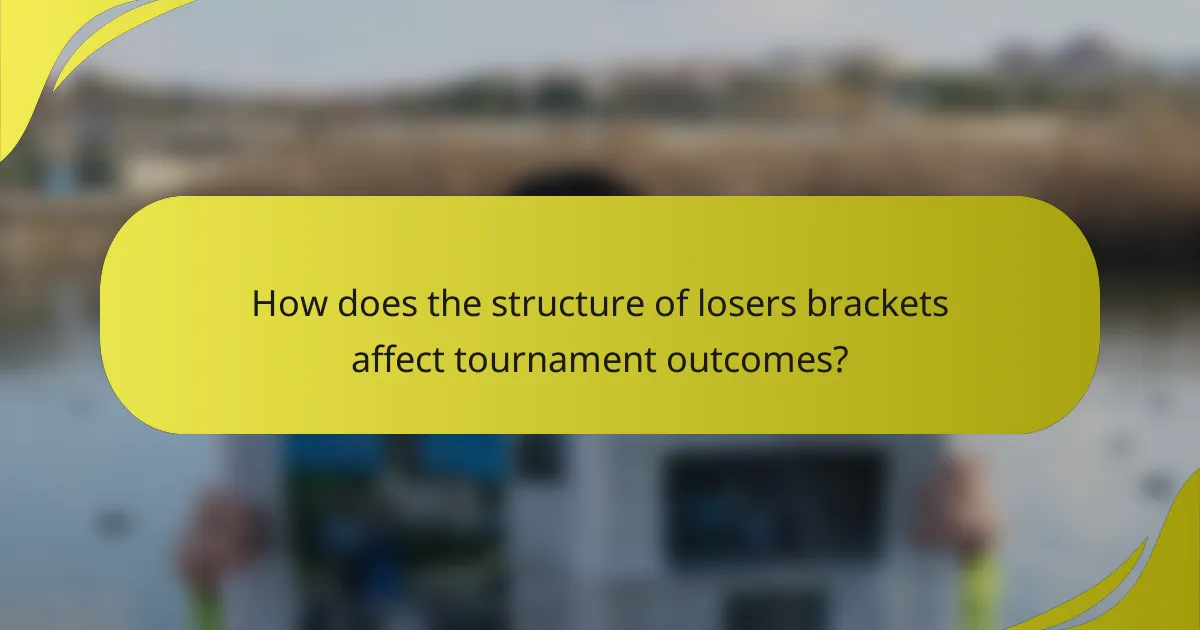Losers bracket formats play a crucial role in shaping tournament dynamics by offering a second chance to teams or players who face early defeats. This structure not only modifies the competitive landscape but also influences strategies and player psychology, ultimately impacting the overall outcome of the event.

How do losers bracket formats impact gameplay?
Losers bracket formats significantly affect gameplay by introducing a second chance for teams or players who lose early in a tournament. This structure not only alters the competitive dynamics but also influences strategies and player psychology throughout the event.
Increased tension and stakes
The presence of a losers bracket raises the stakes for every match, as players know that a single loss does not eliminate them from the competition. This heightened tension can lead to more intense gameplay, as competitors fight to stay in the tournament.
For example, in a double-elimination format, a team that loses in the winners bracket must perform exceptionally well in the losers bracket to reach the finals. This pressure can create thrilling matches, often resulting in unexpected comebacks and upsets.
Enhanced strategic depth
Losers bracket formats encourage teams to develop more nuanced strategies, as they must consider the possibility of facing stronger opponents after an early loss. Teams may opt for riskier plays or unconventional tactics, knowing they have a second chance to recover.
Additionally, players may adjust their strategies based on their opponents’ previous performances in the winners bracket. This adaptability can lead to a more dynamic and engaging competition, as teams must continuously evolve their game plans.
Influence on player morale
Competing in a losers bracket can have a profound impact on player morale. A team that has lost a match may experience a temporary setback, but the opportunity to continue competing can reignite their motivation and focus. This resilience is crucial in maintaining a positive team dynamic.
Conversely, consistent losses in the losers bracket may lead to frustration and decreased confidence. Teams must manage their mental state effectively, employing strategies such as positive reinforcement and team-building exercises to maintain morale during challenging matches.

What are the different types of losers bracket formats?
Losers bracket formats are essential in tournament structures, allowing teams or players who lose a match to continue competing for a chance at victory. The main types include double elimination, single elimination, and round-robin formats, each with unique implications for gameplay and strategy.
Double elimination format
The double elimination format allows a team to lose one match and still remain in the tournament. This structure typically consists of two brackets: a winners bracket and a losers bracket, where teams that lose in the winners bracket drop down to the losers bracket for a second chance.
This format encourages resilience and strategy, as teams must adapt their gameplay to avoid elimination. For example, a team that loses early can still fight through the losers bracket, making adjustments based on previous matches to potentially reach the finals.
Single elimination format
In a single elimination format, teams are eliminated after one loss, making every match critical. This straightforward structure creates high-stakes gameplay, as a single defeat results in immediate disqualification from the tournament.
This format is often used in knockout tournaments, where the intensity of each match can lead to unpredictable outcomes. Teams must prepare thoroughly, as there is no opportunity for recovery once they lose a match.
Round-robin format
The round-robin format involves each team playing against every other team in the tournament. This structure allows for a comprehensive assessment of team performance, as standings are determined by the total wins across all matches.
While this format can be time-consuming, it provides a fair chance for all teams to showcase their skills. Teams must maintain consistent performance throughout the tournament, as even a few losses can significantly impact their standings and chances of advancing to the playoffs.

How does the structure of losers brackets affect tournament outcomes?
The structure of losers brackets significantly influences tournament outcomes by providing a second chance for teams that lose early matches. This format can alter the dynamics of competition, impact player strategies, and ultimately determine which teams advance to the finals.
Impact on match scheduling
Losers brackets require careful match scheduling to accommodate additional games for teams that have lost. This can lead to longer tournament days, as teams must be prepared for potential back-to-back matches. Organizers often need to balance the timing of matches to ensure that players have adequate rest between games.
For example, in a double-elimination tournament, teams may play several matches in a single day, which can lead to scheduling conflicts. Tournament planners must consider the number of teams and the expected length of matches when designing the schedule.
Effect on player fatigue
Player fatigue is a crucial factor in tournaments with losers brackets, as teams that progress further may face multiple matches in a short period. This can lead to decreased performance due to physical and mental exhaustion. Players need to manage their energy levels effectively to maintain peak performance throughout the tournament.
To mitigate fatigue, teams can implement strategies such as proper hydration, nutrition, and rest periods between matches. Understanding the potential for fatigue can help teams prepare better and adjust their strategies accordingly.
Variability in matchups
The losers bracket introduces variability in matchups, as teams may face opponents they would not encounter in a standard single-elimination format. This can lead to unexpected outcomes, as lower-seeded teams have the opportunity to upset higher-seeded opponents. Such variability can create thrilling matches and increase viewer engagement.
For instance, a team that initially loses may adapt their strategies based on previous match experiences, allowing them to perform better in subsequent rounds. This dynamic nature of matchups can keep the tournament exciting and unpredictable.

What strategies are effective in losers bracket play?
Effective strategies in losers bracket play focus on exploiting opponent weaknesses, managing resources wisely, and employing psychological tactics. These approaches can significantly enhance a team’s chances of advancing despite previous losses.
Adapting to opponent weaknesses
Identifying and exploiting the weaknesses of opponents is crucial in losers bracket play. Analyze previous matches to pinpoint areas where opponents struggle, such as specific strategies or player tendencies. For instance, if an opponent has difficulty against aggressive plays, consider adopting a more offensive strategy to capitalize on this vulnerability.
Flexibility is key; be prepared to adjust your tactics mid-game based on how your opponent responds. This adaptability can create openings that lead to advantageous situations.
Resource management techniques
Effective resource management is vital in losers bracket scenarios, where every decision can impact the outcome. Prioritize the allocation of resources, such as time, energy, and in-game currency, to ensure you maintain a competitive edge. For example, if your team has limited health or ammunition, consider playing more defensively to conserve these resources.
Establish a clear plan for resource usage, and communicate it with your team. Regularly assess your resource status and adjust your strategy accordingly to avoid running out at critical moments.
Psychological tactics
Psychological tactics can play a significant role in losers bracket play, as maintaining morale and confidence is essential. Use positive reinforcement to boost team spirit, especially after setbacks. Encourage open communication and support among team members to foster a resilient mindset.
Additionally, consider employing mind games to unsettle opponents. This could involve feigning weakness or unpredictability to force them into making mistakes. However, be cautious not to overdo it, as this can backfire and lead to a loss of focus within your own team.

How do losers brackets influence team dynamics?
Losers brackets significantly impact team dynamics by creating a high-pressure environment that fosters resilience and adaptability. Teams must navigate the challenges of elimination, which often leads to stronger collaboration and strategic adjustments.
Fostering teamwork under pressure
In a losers bracket, teams face the reality of potential elimination, which can enhance their teamwork. The urgency of the situation encourages players to rely on one another, leading to improved synergy and collective problem-solving. For instance, teams often develop more cohesive strategies to counteract their opponents’ strengths.
Additionally, the shared experience of competing in high-stakes matches can strengthen interpersonal bonds. Players may become more supportive of each other, recognizing that their success hinges on collaboration rather than individual performance.
Communication improvements
Effective communication becomes crucial in losers brackets, as teams must quickly adapt their strategies based on real-time feedback. Players often develop shorthand or specific callouts to streamline communication during matches, which can enhance clarity and reduce confusion. This focus on concise communication can lead to better in-game decision-making.
Moreover, regular debriefs after matches can help teams identify communication breakdowns and areas for improvement. By addressing these issues, teams can refine their strategies and ensure that everyone is on the same page moving forward.
Conflict resolution strategies
Conflict is more likely to arise in high-pressure situations, making conflict resolution strategies essential for teams in losers brackets. Establishing clear protocols for addressing disagreements can help maintain a positive team atmosphere. For example, teams might designate a mediator to facilitate discussions when tensions rise.
Additionally, encouraging open dialogue about frustrations can prevent issues from escalating. Teams should create an environment where players feel comfortable expressing concerns, allowing for constructive feedback and collaborative solutions.



